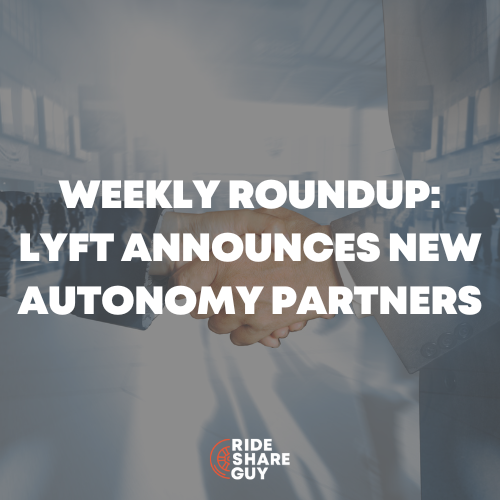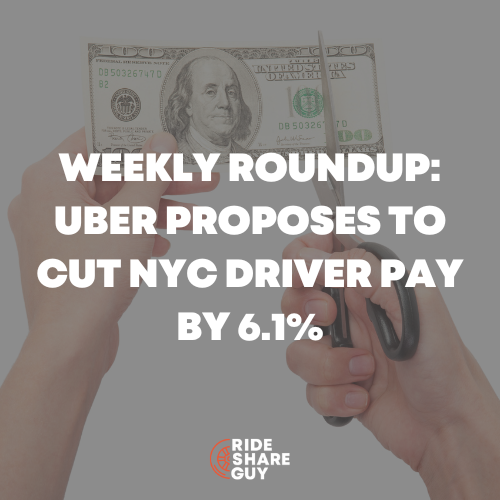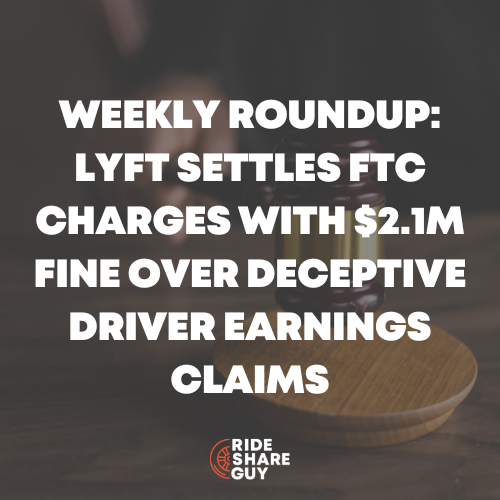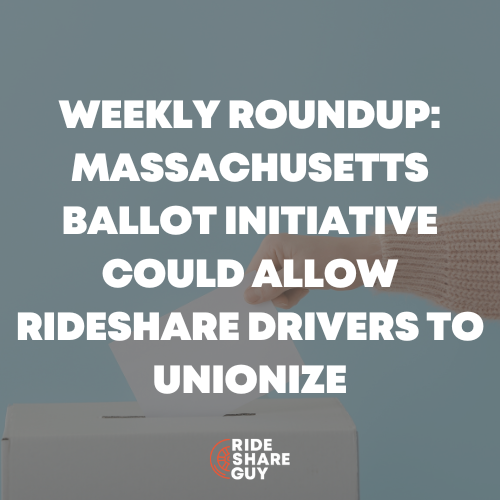In last week’s weekly round-up, we heard about the layoffs that Lyft planned. Now they are claiming the layoffs are to keep in line and remain competitive with Uber. Is this a smart move on Lyft’s part or are they shooting themselves in the foot?
This and more in this week’s weekly round-up with senior RSG contributor Paula Lemar.
Lyft’s CEO Defends Laying Off 1,100 Employees as a Way to Keep Prices Down and Pay Drivers More
Topic Originally Seen on Fortune
Summary
Even before he joined Lyft’s board in 2021, David Risher had taken hundreds of trips as a passenger so he felt like he knew a lot about the ride-hailing service. But he never expected to be thrust into the driver’s seat at a time when Lyft was running like a jalopy.
“I really was gobsmacked,” Risher said during an interview with The Associated Press as he recalled being recently asked to replace Lyft co-founder Logan Green as CEO.
Risher quickly shook off his initial shock and is now making an effort to reverse the San Francisco company’s mounting losses and sagging stock price. Just days after taking over as CEO, Risher came up with a restructuring plan that includes laying off nearly 1,100 employees whose job losses could help him attain stock price incentives potentially worth nearly $1 billion….
My Take
After indicating they would lay off approximately one-quarter of their workforce, Lyft has now stated this was a move to be more in line with Uber as far as fare cost is concerned. In other words, they cut their workforce so they can charge customers less to take rides with them.
I recently went on vacation and Lyft was already pretty well aligned with the cost of Uber, in my opinion. There was even one instance where Lyft was significantly cheaper than Uber, so I gladly pressed the button to book the ride.
But, I’m sure they have a lot more data than just a four-day vacation I had with some friends where the ride offerings tended to be within a few dollars between Uber and Lyft.
Is this a sign of future stability? Or is Lyft just digging a deeper hole for itself by sowing uncertainty among its employees?
Stripe, a Longtime Partner of Lyft, Signs a Big Deal with Uber
Topic Originally Seen on TechCrunch
Summary
Growth at $50 billion fintech Stripe has been slowing this year, but one of its key strategies to reverse that course got a decent push today: Stripe is announcing that it has inked a “strategic payments partnership” with Uber. The pair will work together initially on selected services in eight of Uber’s biggest markets, including the U.S., the U.K., Canada, Mexico, Australia, and Japan.
Some context on this deal: Uber’s big U.S. rival Lyft has been a longtime marquee customer of Stripe’s for payments, and whether or not it was true, that was one reason some assumed Uber and Stripe would not work together. Uber is, however, a much bigger beast, at close to $100 billion transacted annually (Stripe processed $817 billion last year). And Uber is not just a force globally but in the U.S. specifically, where one estimate from YipIt (via WSJ) puts Uber’s rideshare market share currently at a whopping 74%.
Lyft will remain a customer of Stripe, Stripe president Will Gaybrick confirmed to TechCrunch….
My Take
I suppose the takeaway for Lyft is that at least they’ll still have their deal with Stripe, but they won’t be the only ones in the rideshare industry.
Obviously, this looks like a great strategic move for Stripe, but is it just another sign of many that Lyft is barely hanging on by a thread? Or is it just another day?
Stripe has worked with the likes of DoorDash and Point Pickup. While these are delivery services as opposed to rideshare, offering this kind of payment service has proven convenient for drivers and customers.
Strengthening the Shopper-Customer Relationship
Topic Originally Seen on Instacart
Summary
We know that Instacart shoppers go above and beyond to find great replacements, select the best produce, and deliver the highest quality of service to customers every day. Today, customers can see limited information about you when you are shopping and delivering their orders, such as your first name and how many batches you’ve shopped. Now, we’re introducing additional shopper details, which enable customers to view highlights of your unique shopping skills, further get to know you, and feel confident that you will shop and deliver their order with care.
Customers will now be able to see valuable information such as:
- How many 5-star ratings you’ve received
- The compliment badges you’ve earned for quality service including good replacements, quality items, helpful chat, and extra effort
- If you have shopped for them before
- The number of orders you have delivered on time
- And how much time you have saved customers …
My Take
This could be great news for Instacart Shoppers as well as their customers. I know I like consistency over chaos. So, knowing it’s a shopper I’ve had before (and had good service with them) would make me more likely to do a few things…tip more, and order again to name a couple.
Also, it would be great to know if my shopper has a track record for being a good communicator and if they are timely.
Obviously, things happen and not every delivery can be made within the time frame promised, but it’s nice to know if the shopper I get is able to fulfill the basics.
On the other hand, if there are shoppers who don’t always meet these areas that customers expect, I feel like the customer would be more inclined to tip poorly (whether the service was great or not), or even cancel the order in hopes of getting a “better” shopper the next time they book it.
Uber Expands Pooled Ride Option to Five More Cities
Topic Originally Seen on Fox Business
Summary
Uber on Wednesday announced it’s expanding its ride-share program to five more cities as it tries to garner more users as the ride-sharing competition between it and Lyft heats up.
UberX Share will be expanded to Baltimore, Miami, Nashville, Philadelphia, and Washington, D.C. “in the coming weeks,” Shin-Pei Tsay, the head of Cities & Transportation Policy at Uber, said in a post.
The company re-launched the program in New York City, Los Angeles, Chicago, San Francisco, Phoenix, San Diego, Portland, Indianapolis, and Pittsburgh last summer after briefly pausing in 2020….
My Take
Uber Pool is a sticky subject for a lot of drivers. It’s cheaper for the customers, but there are potentially multiple stops to either pick up and/or drop off other customers along your route.
Not all customers seem to be aware of that because a lot of drivers have heard endless complaints from their riders about it.
Many people don’t think before they click. They see the cheaper option and go for it without realizing it might take them longer to get where they are going and they might not be dropped off directly in front of the building they are aiming for.
But, obviously, Uber seems to find value in the service, or else they wouldn’t be expanding it to more markets. It must be one of the more profitable services they provide, which makes sense.
They are having drivers transport more people, and while each person pays less, it’s more that will line Uber’s pockets than it would have been with, say, 3 separate trips ordered.
Do you have Uber Pool available in your area? Share your experience with us!
Waymo Barreling Ahead with Bigger Robotaxi Coverage in San Francisco and Phoenix
Topic Originally Seen on The Verge
Summary
Waymo is dramatically expanding its robotaxi service areas in Phoenix and San Francisco as it seeks to gain new customers, generate more revenue, and make a convincing argument that self-driving cars are more than just an expensive fad.
In Phoenix, the company’s autonomous Jaguar I-PACE vehicles will now cover a total of 180 square miles, or roughly twice the size of its current map and four times the size of the area that the company served when it first launched its ride-hailing operation in 2020.
Waymo’s two distinct service areas, Downtown Phoenix and the East Valley communities of Tempe, Gilbert, Mesa, and Chandler, will be connected for the first time. And the company’s robotaxis will also now serve the town of Scottsdale, known for its spa resorts and golf courses….
My Take
Are driverless vehicles taking over faster than we thought? Everyone I talk to never seems all that worried about driverless vehicles taking over for rideshare drivers anytime soon.
There are still so many factors that need to be considered—vehicle cleanliness, construction, rerouting, etc.
It seems like Waymo is making strides to do its best to replace drivers. This expansion is the first we’ve heard from them in a while, but it shows they must feel like they are doing something right. Though, even this article points out that these cars aren’t able to go anywhere and do anything like a driver-driven vehicle would.
If you’re a driver in Phoenix, do you feel like you’ve been affected by Waymo’s presence?
If You Hate Tipping Delivery People, Drivers for Uber, Lyft, and DoorDash Want You to Consider these 4 Main Arguments Why You Should Anyway
Topic Originally Seen on Business Insider
Summary
“No tip, no trip.”
That’s the saying Sergio Avedian, a 55-year-old Uber and DoorDash driver in the Los Angeles area, has adopted over his eight years of part-time gig work.
During the 10 to 20 hours he drives per week, Avedian said he only accepts roughly 20% of the orders he sees come across the nine food-delivery apps he has on his phone. He told Insider that low or nonexistent upfront tips, or tips placed before a driver delivers the order, are the biggest reason.
“I learned really fast that this is not profitable without tips,” he said. “And now I go, ‘No tip, no trip, buddy. You want your food, you tip. If not, it ain’t going to be me.’…
My Take
As you can see, RSG’s own Sergio Avedian is quoted heavily throughout this article. He holds the same mentality as many delivery drivers: No tip, no trip.
Tipping is such a touchy subject for many. Customers lean toward the idea that tips are only for outstanding, above-and-beyond service, while drivers are paid piddly amounts that barely cover the expenses of using their vehicle for this gig.
They are putting their butts on the line, using their personal vehicles to hand deliver food or goods and drivers feel like a tip is required or should be.
Tipping will be an ongoing issue until or unless everyone gets on the same page about it, or until the businesses actually start paying their drivers a living wage instead of pennies on the dollar compared to non-service related industry jobs.
What is your take on tips? Is it right for drivers to demand tips or should they be reserved for excellent service?





